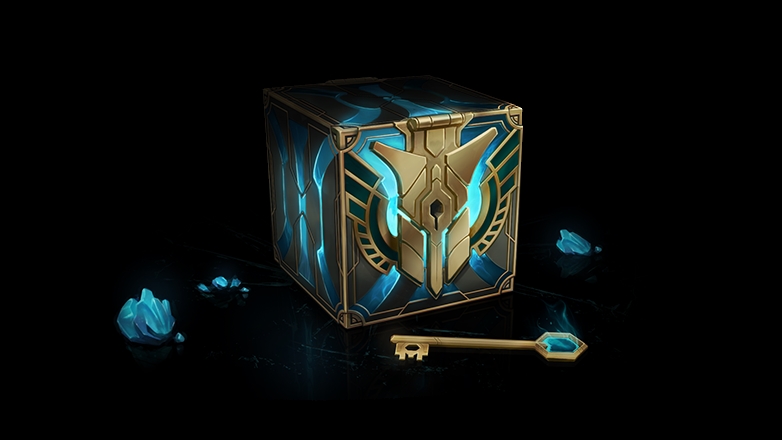Riot crafts an opportunity to support esports

Riot's recently announced big news regarding their in-game purchaseables—one that might seem just a little quaint to the rest of the esports ecosystem. They're soon to introduce crates and keys not totally unlike those found in Counter-Strike: Global Offensive. To summarize, performing well in a game can earn you up to four crates a month, while winning games (regardless of performance) grants you keys to crack the crates open. Both, of course, can be purchased for actual cash.
The crates then floods your fresh new inventory space with an assortment of randomized collectibles. New icons can be found via the crates, plus new ward skins as well. But the most exciting prospect for most players is the ability to craft "free" champion skins from the Shard and Essence drops—and "free" doesn't mean cheap recolors or otherwise passe skins (in fact, Riot's controversial "Chroma" color packs are officially not part of the initial launch). Legacy, Legendary and Ultimate skins are all included—though not the so-called Limited tier.
As is pretty standard with Riot's recent rewards programs, your odds of attaining loot are best when you've got friends to play with, as a particularly successful S-ranked game from any player in a premade group results in rewards for everybody in that group. It's a pretty nice system overall, though nothing about it is particularly groundbreaking. As a rewards program to encourage player investment it stresses fairness, or at least minimal consumer pain, and the programmers behind it officially want to avoid a system where you're prone to getting "bad" drops from the randomizer.
The tricky thing is where and how it overlaps with League of Legends' esports economy, and to that end their question-and-answer session was entirely silent on details.
Trickle down
League of Legends has few ways for players to directly support teams. The only real link: team icon sales, of which commit 20% of their sold value to teams, as of last year. That actually isn't all that much when icons are deliberately dirt-cheap—the cheapest things you can get with Riot Points, in fact (at least, so far: pricing for crates and keys are not yet known). What's worrisome, however, is a lack of announcements regarding how the new loot system affects that thin line of assistance to the teams. If the payment given to the teams are based on actual sales, the crate drops might end up hurting the wildcard region teams that lack the big-money organizational support now found in North America and China—not to mention the teams within the LCS itself that aren't part of the recent empire-building gold rush spearheaded by Rick Fox and others.
My direct concern regarding the icons might be misplaced, of course. If sales are only based on the number of accounts newly flagged with team icon access, then it hardly matters how the players got the icon. But the specificity of the issue occludes the greater problem: in terms of rewarding pro players for their contributions to audience retention, League of Legends is falling woefully behind the industry standard.
Previously, Riot has indicated unwillingness to adopt the crowdfunding model for tournament prize pools as used by Dota 2 and others. And, actually, I'm okay with that. The big tournament numbers sprouting off the compendium sales model has some long-term sustainability issues: already, Dota 2 fans are complaining about unmet expectations with compendium award levels, while Smash Bros.' take on combining it with player invites has generated some unnecessary ill will. And while the continued growth of the esports scene as a whole has kept the numbers climbing year after year, nobody actually wants to be the first to find out what happens when the records stop breaking, and people start wondering if the scene's starting to pull a StarCraft.
The biggest gaming news, reviews and hardware deals
Keep up to date with the most important stories and the best deals, as picked by the PC Gamer team.
There's also the issue that crowdfunded tournament prizes are an extremely top-down solution which also presents a sustainability issue. Sure, the top teams get rich—but the top teams and players won't play forever, and who's going to replace them afterward? It takes time and effort to create the next batch of talent, whenever age or carpal tunneling strikes down a crowd favorite, and both time and effort are only afforded if they don't need to worry about food and rent while utilizing them.
That's where Riot's weekly circuit model has its advantages: though there is a lot to criticize about its handling of the Challenger and Wildcard programs (including the lack of even that thin bit of icon funding assistance for Challengers), the minimum stipends and funding it does provide for teams officially under its competitive aegis guarantees a stable basis for talent development.
It just needs to be a lot more than "minimum."
Matched value
The NCAA debacle is probably a good analogy here. College basketball is a huge, rich endeavor. The media focus, advertisers, and overall cultural impact it has is completely dependent on the kids that play on its courts—no players, no broadcast, no advertisers, no paycheck. So small wonder that the world of basketball had been enmeshed in the last year over heated debates whether collegiate athletes should be monetarily compensated.
There's a lot of factors that go into that debate—the legality of it, antitrust issues, the NCAA's amateur focus in its sports programs—but whether the collegiate athletes are the capital upon which the NCAA builds its wealth should not be disputable.
Similarly so with esports players and the games they play. Riot, in particular, has spent the last few years very carefully cultivating personality-driven focuses on the players under their competitive program. The names of Doublelift, Froggen, Faker and everybody else have very nearly become household names—especially now that ESPN's officially onboard with the esports coverage gig (congrats to my recently-hired colleagues now under the Disney aegis). The value they bring is indisputable—not when the celebrity names attached to League of Legends include the son of the richest man in China (Wang Sicong), Taiwan's pop cultural demigod (Jay Chou), America's best-known entrepreneurs (Mark Cuban), and former basketball stars (Rick Fox).
That 20% of the value of a cheap in-game icon suddenly doesn't seem so gracious in light of all of that, does it? And unlike the NCAA, Riot's consistently stressed that esports is a profession in their eyes—a message drummed out again and again over the course of the last five years.
The new crate-and-key system is a tremendous opportunity for them to increase the scope of their support for pro players. Much as how sticker capsule sales have driven support for Counter-Strike teams, Riot now has a system where they can use the increase in cosmetic options to drive greater engagement with their esports teams. Limited-edition crate/key combos tied to Challenger tournaments, with heightened drop rates for legendary skins, team wards, icons, and profile banners, don't just drive up sales—they also cast a much-needed spotlight to upcoming talent and teams that would otherwise languish in obscurity.
Not just for Challengers, either. Tying themed crate/key drops to watching LCS matches through Twitch, or the upcoming client update, provably makes for a captive audience—a synergistic amplification that benefits not just Riot or LCS advertisers, and not even just the teams involved, but everybody that plays the game, participates in its culture, and cheers on the sick plays on stream.
So, here's hoping that silence isn't absence.

PC Gamer Pro is dedicated to esports and competitive gaming. Check back every day for exciting, fun and informative articles about League of Legends, Dota 2, Hearthstone, CS:GO and more. GL HF!

